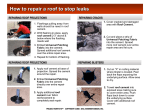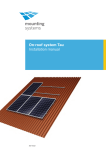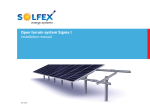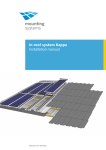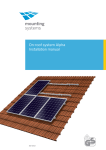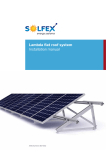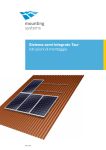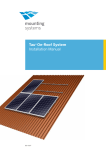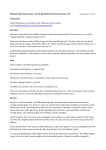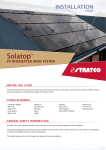Download In-roof system Theta Installation manual
Transcript
In-roof system Theta Installation manual December 2009 Table of contents ENGLISH Table of contents 1 Introduction 4 6 1.1 Overview 4 1.2 Intended use 4 1.3 Standards and technical directives 4 1.4 About this manual 4 Safety 5 2.1 Basic safety instructions 5 2.2 Working on roofs 5 2.3 Warnings 5 2.4 Responsibilities of the operator 6 Technical description 7 3.1 System overview 7 3.2 Scope of delivery 7 3.3 Technical specifications 7 Planning the module field 8 4.1 Operating conditions 8 4.2 Landscape installation 9 4.3 Portrait installation 10 Important installation information 11 5.1 Preparation work 11 5.2 Installation aids and required tools 11 5.3 Additionally required material 11 2 3 12.2009 Theta-MA-ENG-0912 4 5 Theta Installation manual Installation 12 6.1 Roof preparation 12 6.2 Installing the substructure Laying the sealing strip Installing the lower profile filler Option A: Foam profile filler with short lower adapter and narrow sealing strip Option B: Comb profile filler with intermediate adapter and wide sealing strip Laying the corrugated metal sheets 13 13 14 6.3 14 14 15 Installing the adapter (landsacpe installation) Installing of the short or intermediate landscape adapters Using the steps (for landscape installation) Installing the short or long lateral adapters 16 17 17 6.4 Installing the adapter (portrait installation) 18 6.5 Installing the lateral flashings 18 6.6 Installing the top flashing 19 6.7 Installing the PV modules Attaching the PV modules to the outer edge of the module field (portrait and landscape installation) Inserting the Quickstone Attaching the PV modules within the module field (portrait and landscape installation) 20 20 Retiling the roof 21 6.8 16 20 20 3 1 Introduction Introduction 1.1 Overview ENGLISH 1 Theta is an in-roof system for PV modules. It enables direct integration of PV modules (framed or unframed) into the roof cladding independently of the type of roof covering. All components are pre-assembled on the basis of your order and replace the previous roof covering. Theta is mounted on the existing or on new battens of the roof construction. The roof can thus be completely or partially covered with PV modules. 1.2 Intended use The Theta in-roof system is to be used only for the roof installation of PV modules. Any other use is considered improper. The observance of the information in these assembly instructions is a part of proper use. Mounting Systems GmbH is not liable for damage that results from the non-observance of assembly instructions, in particular the safety information, or from the improper use of the product. 1.3 Standards and technical directives When planned correctly, Theta fulfils the following norms and technical directives: | DIN 1055 Actions on structures, section 100: Basis of design, safety concept and design rules | DIN 1055 Actions on structures, Part 4: Wind actions | DIN 1055 Actions on structures, Part 5: Snow and ice loads 1.4 Subject These instructions describe the installation of the Theta in-roof system. The drawings in this manual illustrate the mounting of PV modules on a tile roof (Frankfurter Pfanne, roofing tile). Please note the specifications for mounting on other roof types. User group This manual is intended for qualified personnel with a basic knowledge of mechanics, hand tools and mechanical skills. Orientation aids Eurocode 1: Actions on structures – Part 1-3: General actions, snow loads; German version EN 1991-1-3: 2003 The following aids will improve orientation when using these instructions: | Eurocode 1: Actions on structures – Part 1-4: General actions, wind actions; German version EN 1991-1-4: 2005 Position numbers Eurocode 9 – DIN V ENV 1999-1-1: Design of aluminium structures The footers display the product name, the document title and the page number. About this manual | | Footers The illustrations show the individual components with position numbers referred to in the text. The position numbers are shown as (1) and (2) . Headers The headers give the current chapter overview. Theta Installation manual 4 2 Safety Safety 2.1 Basic safety instructions ENGLISH 2 The following basic safety information and warnings are an essential part of these instructions and have fundamental importance for handling of this product: | Ensure that the product corresponds to the static requirements on-site prior to every assembly and installation. 2.2 Working on roofs When working on roofs, note the following instructions: | | Pay attention to accident prevention regulations for working on roofs. If appropriate, use a barrier to protect against falling parts. In line with accident prevention regulations, work on roofs should be carried out using safety harnesses for individuals or safety scaffolding. 2.3 Warnings The warning notes used in this manual identify safety related information.They consist of: | Warning symbol (pictograph) | Indicator word to denote the danger level | Information about type and source of the danger | Information about possible consequences if the danger is not observed | Measures for avoiding the danger and for preventing injuries or property damages | Observe occupational health and safety regulations of the employer's liability insurance association. | Observe the relevant local safety regulations. | Wear a hard hat, protective gloves and safety shoes. | | Wear sunglasses in the event of glare from the sun during the installation. Before stepping on to the roof, check the loadbearing capability of all parts which are under stress. | Use fall protection. | Use protective equipment to guard against falling even when carrying out short jobs. DANGER | Do not carry materials on to the roof via ladders, but rather use suitable lifting gear. Denotes a major risk, failure to observe which could lead to serious injury or death. | | A second person must be present during the entire installation process to assist in the event of an accident. A copy of this installation manual must be kept in the direct vicinity of the unit. The heading of the warning notes identifies one of the following danger levels: WARNING WARNING Denotes a potentially dangerous situation which may lead to moderate to serious physical injury and property damage. CAUTION CAUTION Theta Installation manual Denotes a potential risk which may lead to physical injury and property damage. 5 2 Safety 2.4 Responsibilities of the operator | Ensure that the installation of the system is only performed by persons with manual skills and basic knowledge of mechanics. | Ensure that the commissioned installation personnel can evaluate the work assigned to them and can recognize possible dangers. | Ensure that the persons commissioned are familiar with the system components. | Ensure that the installation manual is accessible during the assembly. The mounting instructions are an integral part of this product. | Ensure that the installation manual and in particular the warnings have been read and understood by the autorized installation personnel prior to assembly. | Ensure that the permissible operating conditions (see chapter 4.1, page 6) have been upheld. Mounting Systems GmbH will not be held liable for damage which results from a violation of these conditions. | Ensure that the roof construction has the required load-bearing capacity, in particular in the vicinity of the force transmission points. | Ensure that the durability of the mounted connections and roof attachments are guaranteed. | Ensure that the appropriate lifting equipment is used for the mounting process. | Ensure that the water tightness of the mounted roof installation is guaranteed. | Ensure that only Mounting Systems components are used, also in case of replacement. Otherwise the warranty claim is void. Theta Installation manual ENGLISH The system operator has the following safety relevant responsibilities: 6 3 Technical description Technical description 3.1 System overview ENGLISH 3 (1) (2) (3) (4) (5) (6) (7) (8) (9) (1) Lateral flashing Top flashing Corrugated metal sheet PV module Long adapter with module clamp (option A) Short adapter with module end clamp (option A) Short adapter with module clamp (option B) Intermediate adapter with module end clamp (option B) Sealing strip (2) (4) Note: (3) This illustration shows the landscape mounting position of the PV module. Other adapters must be used for portrait installation. The required calottes necessary for attaching the corrugated sheets to the roof are not shown here. 3.2 (5) Scope of delivery Theta includes all system components and accessory components which are necessary for installation.The delivery content corresponds to the configuration of the PV unit. Additional roof battens and their respective fixing materials are not included in delivery. 3.3 (7) Technical specifications Support profiles, module (end) clamps Extruded aluminium EN AW 6060 T6/6063 T66 Small parts Stainless steel (V2A) Flashings Aluminium, EN AW 5005 Corrugated metal sheet Aluminium, EN AW 3005 Theta Installation manual (9) (6) (8) 7 4 Planning the module field 4.1 Operating conditions ENGLISH 4 Planning the module field Additional roof battens Planning information If the existing roof battens do not correspond to the required points in the module field, additional roof battens will be necessary at the following points: The following must be observed for planning the module field: Application range Pitched roof Roof covering Any Roof pitch Depending on the regular roof pitch of the remaining roof covering, min. of 10°; max 45° | | Fixation of the sealing strip PV module Any size | Fixation of the top flashing. Roof construction The roof construction must have adequate load-bearing capacity. The roof structure must comply with national requirements and standards (for example, rear ventilation). Additional roof battens and their respective fixing materials are not included in delivery. Building height Max. 12 m Snow load Max. 1.44 kN/m²* Wind load Max. 39 m/s* Roof batten spacing Max. 320 mm** Roof batten thickness Min. 35 mm Roof batten width Min. 35 mm | The standard Theta components are designed for mounting the module field into a tiled roof. Mounting on other types of roof coverings must always be done by a professional roofing company. | There must be a distance of at least three rows of tiles between the top edge of the module field and the roof ridge. If this is not the case, the top edge completion must be performed by a roofing company to guarantee the water tightness and durability of Theta. Should the ridge tiles not be fixed, then there must be a distance of at least one row of tiles between the top edge of the module field and the roof ridge. | Direct connections of the module field to the roof ridge, roof verge or the eaves must be performed by a professional roofing company in all cases. Fixation of upper adapters * The maximum values may vary, depending on module size, building and location. **Applies to installation on existing battens. For installation on new battens: Position the battens at the quarter points of the modules. Module field planning is based on: | Module size (L x W x H) | Module positioning (portrait, landscape) | Number of modules | Roof batten spacing Theta Installation manual 8 4 Planning the module field Landscape installation (4) The modules can be fixed along the entire length of the adapters. (5) (1) Height of the module field: Module width x number of modules vertically + ((number of modules vertically – 1) x 19 mm) + 50 mm (2) Width of the module field: Module length x number of modules horizontally + ((number of modules horizontally – 1) x 19 mm) (3) Additional roof battens for attaching the sealing strip and the lower adapter: Distance between new batten (center) and edge of the below tiles: 120 mm (for the short adapter) or 220 mm (for the intermediate adapter). (4) Additional roof battens for fixing the top adapter: Height of module field – 30 mm (center of batten) (5) Additional roof battens for fixing the top flashing: Height of module field + 280 mm (center of batten). (6) Horizontal distance between adapters: Approx. at quarter points of the module = ½ module length (observe the information provided by the module manufacturer) (7) Vertical distance between adapters: Can be calculated from the module dimensions. Place the adapter correctly in the inner part of the module field so that its centre point is located in the 19 mm clearance space between the modules. A minimum distance of 25 mm between the adapter edge and module field edge must be kept for the outer top and bottom adapters. (7) (1) (6) (3) (2) Choosing between short and long adapters for landscape installation Should the existing battens be replaced or supplemented during the course of precise module arrangement planning, then the short adapters may be used in the inner surface area. The long adapters facilitate more flexibility in the vertical fixation of the PV modules, so that in some cases, when installing the mounting system, no further roof battens need to be added to the roof truss. For the lower edge of the PV field, short or intermediate adapters may be used. The intermediate adapters enable (in connection with a correspondingly wide sealing strip) a larger overlapping in the sealing strip area. This may be necessary, depending on the national standards. Theta Installation manual (6) (7) (3) 9 ENGLISH 4.2 4.2 Landscape installation 4 Planning the module field Portrait installation (1) Width of the module field: Module width x number of modules horizontally + ((number of modules horizontally – 1) x 19 mm) + 50 mm (2) Heigth of the module field: Module length x number of modules vertically + ((number of modules vertically – 1) x 19 mm) (3) Additional roof battens for fixing the sealing strip: Distance between new batten (center) and edge of the below tiles: 120 mm or 220 mm, depending on the chosen sealing strip. (4) Additional roof battens for fixing the upper edge of the PV field: Height of the module field - 30 mm (center of batten). (5) Additional roof battens for fixing the top flashing: Height of the module field + 280 mm (center of batten). (6) Vertical distance between adapters: Approx. at quarter points of the module = ½ module length (observe the information provided by the module manufacturer). Spacing is based on the roof batten raster. In the case of a particularly unfortunate batten raster, additional battens may have to be installed). (7) Horizontal distance between adapters: Can be calculated from the module dimensions. Position the adapter in the inner part of the module field so that its centre point is located in the 19 mm clearance space between the modules. A minimum distance of 25 mm must separate the adapter edge of the adapters on the right and left edge and the module field edge. ENGLISH 4.3 4.3 Portrait installation (1) (7) (5) (4) (6) (2) (3) Theta Installation manual 10 5 Important installation information Important installation information 5.1 Preparation work ENGLISH 5 5.3 Additionally required material Mounting Systems recommends that you inform yourself about the local conditions prior to ordering Theta. In particular, be familiar with: Depending on the system plan, the following additional materials may be necessary: | Double-sided adhesive tape | The roof construction | Roof battens | The roof batten thickness | Appropriate wood screws for fixing roof battens | The roof batten quality | | The roof batten spacing Appropriate material for sealing and additional fixing of the surrounding tiles, as needed. 5.2 Installation aids and required tools The following tools will be needed for the installation of Theta: | Roof ladder | Folding rule | Chalk line to align the adapters | Aluminium level (to check the flatness of the battens and the module field) | Cut-off grinder with a stone disc (to fit the tiles) | Metal cutters (for cutting the metal sheets, sealing strip, etc.) | Roofing tinsmith tools, i.e. crimping or clinching pliers (for possible work on the flashings) | Rubber hammer | 6 mm Allen key | Cordless drill with an 8 mm hex headbit (for adapter screws) and torx bit (for calottes and roofing screws) Theta Installation manual 11 6 Installation Installation 6.1 Roof preparation ENGLISH 6 Removing the roof covering Installing additional roof battens Potentially mortal danger from falls and falling objects Material damage from faulty installation When working on the roof, components may fall down, or persons may fall off. | Protect yourself against falling (use scaffolding or barriers if necessary). | Mark the danger zone on the ground (concerning falling components) and bar access to unauthorised persons. | Theta CAUTION | (1) Wear a hard hat. | Take note of the possible effect of wind gusts when transporting modules and sheets. | After the assembly is complete, ensure secure fixing of the mounting system, the PV modules and the tiles. Installation manual Ensure that the roof battens are sufficiently attached to the rafters. Installation: (2) Do not remain in the danger zone. | If the additional roof battens are not sufficiently fixed, they will not resist increased wind loads. | Attach the additional roof battens at the appropriate places in a professional manner (see point 4, "Planning the module field"). (1) Roof covering (for example tiles) (2) Roof substructure (for example wooden battens) Installation: | Remove roof covering for the surface area of the modules. On the lateral and top edges remove an additional row of tiles beyond what is necessary for the actual module field. | In the case of an uneven roof truss, it may be necessary to adjust the height of the roof battens. | If necessary, lay a roofing membrane under the intended module field. Should the insulation be in direct contact with the roofing membrane, the vapour permeability of the roofing membrane must be ensured. 12 6 Installation Installing the substructure Installation: Laying the sealing strip | Unroll the sealing strip along the lower edge of the uncovered roof surface. | Cut the sealing strip for the length of the surface area + one extra tile width on the left and right. | Allow for adequate spacing (5 cm) between the upper edge of the roof tile and the lower edge of the corrugated metal sheet to avoid an edge that is too sharp. Also allow for adequate overlapping by the corrugated sheets (depending on the type of sealing strip, see pg. 14). | After fixing the sealing strip (see pg. 14), adapt the shape of the strip to the shape of the tiles, taking care to avoid the formation of sharp edges. (1) ENGLISH 6.2 (2) (1) Sealing strip (2) Additionally installed battens for sealing strip fixation Leaky construction CAUTION If the sealing strip does not sufficiently overlap the roof tiles, the roof may become subject to leaks. | Theta The sealing strip must vertically overlap the tiles at least as much as the tiles overlap themselves. In case of very curved roof tiles, it may be advisable to flatten the upper edge of the tile underneath the sealing strip prior to laying. In that way, sharp edges and water accumulation can be avoided. Installation manual 13 6 Installation Option B: Comb profile filler with intermediate lower adapters and wide sealing strip (in this case: Perform) ENGLISH Installing the lower profile filler: Option A: Foam profile filler with short lower adapter and narrow sealing strip (in this case: MetallRoll) (2) (3) (1) 50 mm (3) 70 mm (1) (2) 50 mm 170 mm (view from above) (view from above) (1) Foam profile filler (2) Sealing strip (in this case: MetallRoll) (3) Lower edge of the corrugated metal sheet Installation: Leaky construction CAUTION If the sealing strip is not sufficiently overlapped by the corrugated metal sheets, the roof covering may become subject to leaks. | Installation: Leaky construction CAUTION The sealing strip must begin no less than 100 mm above the planned lower edge of the corrugated metal sheet. An allowance of a further 5 cm up to the roof tile edge has to be made. | Guide the foam profile filler up to the lateral flashings of the module field. | Fix the profile filler on the sealing strip with doublesided adhesive tape in such a way that later (by means of adapters or calottes), it can be screwed onto the roof batten directly underneath it. | (1) Comb profile filler (2) Sealing strip (in this case: Perform) (3) Lower edge of the corrugated sheet If the sealing strip is not sufficiently overlapped by the corrugated sheet, the roof covering may become subject to leaks. | The sealing strip must begin no less than 200 mm above the planned lower edge of the corrugated metal sheet, and an allowance of a further 5 cm up to the roof tile edge has to be made. | Guide the comb profile filler up to the lateral flashings of the module field. | Attach the profile filler to the roof batten directly underneath using roofing screws. Should MetalRoll be used as the sealing strip, the top 2 cm of the adhesive surface can be completely turned over, so that the adhesive surface is facing upwards, and the profile filler can be attached without additional adhesive tape. Theta Installation manual 14 6 Installation Laying the corrugated metal sheets | Place the lower edge of the corrugated sheet onto the sealing strip with adequate overlapping: 100 mm for the foam profile filler and 150 mm for the comb profile filler (see "Installing the lower profile filler"). | Position the corrugated sheets so that the sides end with corrugation pointing downward to the roof truss. | For normal rectangular roofs, lay the lower edge of the bottom row of corrugated metal sheets parallel to the eaves. (1) ENGLISH Installation: (1) (2) (3) (1) (2) (3) (4) (4) Corrugated metal sheet Roofing screw 4.5 x 45mm with calotte Sheet metal screw 6.5 x 65 mm (self drilling) Adapter (in this case: short adapter for landscape installation) | Sheets must overlap above each other by at least 200 mm vertically and by at least 80 mm = 2 high points of the corrugation horizontally. Attach the corrugated metal sheets (see point 6.3/ 6.4 "Installing the adapters") to the roof with 6.5 x 65 mm sheet metal screws together with the adapters, the profile filler and the lateral flashings. If necessary, use additional 4.5 x 45 mm roofing screws and calottes, so that at least 6 fixing points per m² are provided. | Lay the corrugated sheets in sequence starting from the bottom and working upwards, and plan the side overlap in accordance with the main wind direction. Position the corrugated sheets so that they correspond to the entire module field. If necessary, use additional roofing screws and calottes to attach the overlapping points. | After laying the lateral and top flashings, attach the outer edges of the corrugated sheet surface area every 50 cm with roofing screws and calottes. Leaky construction CAUTION If the corrugated metal sheets do not sufficiently overlap, the roof may become subject to leaks. | | (1) Mounting aid Installation: | To expedite the installation process, the mounting aid can be used starting at the second row of sheets. The mounting aid cannot be used on the last / top row, as the height of the corrugated sheet must be adjusted to the intended module field height, and the mounting aid's prescribed overlap of 200 mm must therefore be exceeded there. Material damage CAUTION Theta Walking on the corrugated sheets can cause dents or tears. | Do not walk or stand on the corrugated sheets. | Use of a roofer's ladder is recommended. Installation manual 15 6.3 Installing the adapters (landscape installation) Installing of the short or intermediate landscape adapters (on the lower edge of the module field) Material damage CAUTION (1) Walking on the corrugated sheets can cause dents or tears. | Do not walk or stand on the corrugated sheets. | Use of a roofer's ladder is recommended. (2) (3) | Position the corrugated metal sheets to the prescribed overlap onto the sealing strip and profile filler, and align the sheets. | Screw the adapters with two 6.5 x 65 mm sheet metal screws each (see chapter 4, "Planning the module field") onto the roof batten lying directly underneath at the designated points. At the same time, attach the corrugated sheet, sealing strip and profile filler. Material damage CAUTION Screws that are not attached in the centre of the roof batten may rip out. | (1) Position all screws in the centre of the battens. (4) Fix the adapters from the bottom, moving upwards. After installing the bottom row, you may use the provided steps. The steps can be inserted into every adapter, as needed. While installing the adapters, repeatedly check that the surface is flat, for example with an aluminium level. (1) (2) (3) (4) Sheet metal screws, 6.5 x 65 mm (self-drilling) Short landscape adapter Corrugated metal sheet Intermediate adapter Installation: Theta Installation manual | Lay out the first row of corrugated sheets above the sealing strip, and make the side points of overlap correspond to the final surface width. | Position the short or intermediate landscape adapters on the lower corrugated sheet edge according to the plan (see chapter 4, "Planning the module field"). The holes of the adapter should face upwards, the round tip in the adapter's Quickstone channel should be facing left (see detailed illustration). | If one of the profile filler fixation points lines up exactly with one of the adapters, remove this screw from the profile filler. 16 ENGLISH 6 Installation 6 Installation Installing the short or long lateral adapters (in the centre and upper range of the module field) (1) Attention: | For landscape installation, the top flashing must be fixed before the installation of the top adapter row (see chapter 6.6 "Installing the top flashing"). | Ensure professional potential equalisation of the metal surface without damaging the leak tightness. (1) (2) (2) (3) (4) (1) (2) (3) (4) Step Landscape adapter Quickstone fixation Quickstone channel Mortal danger due to incorrectly mounted steps Incorrectly mounted steps or adapters can result in falls. The long landscape adapter is used when no new battens are to be installed in the inner surface area. Otherwise, short adapters can be used. The top adapter row must be fitted with short adapters. Protect yourself against falling. Installation: | The step is not a safety-related element. | | Check the stability of the steps set in the adapters. For orientation: Mark the position of the roof battens on the corrugated sheet by using a chalk line. | | Ensure that the screw connections are tight. If using the steps, ensure the correct positioning of the Quickstone channel of the adapter (rounded tip in the Quickstone channel facing left, see detailed illustration). | In accordance with the plan, screw long or short adapters on the designated points (see page 6, "Planning the module field") with 6.5 x 65 mm sheet metal screws onto the roof batten lying directly underneath. Use the corresponding holes in the adapters – 2 each for the short, or 4 for the long adapters. Slide the step into the Quickstone channel of the adapter from above as far as it will go. Theta (1) Sheet metal screw, 6.5 x 65 mm (self-drilling) (2) Long landscape adapter (3) Corrugated metal sheet | Installation: | (3) Installation manual 17 ENGLISH Using the steps (for landscape installation) 6.4 Installing the adapter (portrait installation) Attention: | Material damage CAUTION Walking on the corrugated sheets can cause dents or tears. | Do not walk or stand on the corrugated sheets. | We recommend the use of a roofer's ladder. | 6.5 | For portrait installation, the lateral flashings must be installed before fixing the outer adapters (see point 6.5 "Installing the lateral flashings"). Ensure a professional overlapping of the sheets by using roofing tinsmith tools such as clinching pliers. | Ensure professional potential equalisation of the metal surface without damaging the leak tightness. By using the fixation clips and roofing screws, fix the flashing on the outer edge at least every 50 cm. | Fix the flashing on the inside by using roofing screws and calottes or adapters (only for portrait installation) at least every 500 mm. Installing the lateral flashings Material damage CAUTION (1) Screws that are not attached in the centre of the roof batten may rip out. | Position all screws in the centre of the battens. 200 mm (1) (2) (2) (1) (1) Sheet metal screws, 6.5 x 65 mm (self-drilling) (2) Portrait adapter (two-part) Installation: | For orientation: Mark the position of the roof battens on the corrugated metal sheet by using a chalk line. | Screw the portrait adapters at the points specified in the planning (see page 6, "Planning the module field") with two 6.5 x 65 mm sheet metal screws each onto the roof batten lying directly underneath. Use the corresponding drill holes in the adapter. | Install the two parts of the portrait adapters in the module field precisely aligned above each other. | For mounting on the lateral edges, the perforated rail can be slid sideways up to 50 mm beyond the basis to ensure a clean transition between roof and module field. Theta Installation manual (1) Lateral flashing (2) Fixation clip for 4.5x45 mm roofing screws Installation: | Position the lateral flashings so that 2 waves of the flashing overlap the corrugated metal sheet on the right and left side of the module field. | Align the sheets on the lower edge of the corrugated metal sheet area. | If using several lateral flashings, overlap them by at least 200 mm vertically – if necessary, shorten the topmost lateral flashing corresponding to the size of the corrugated metal sheet area. 18 ENGLISH 6 Installation 6.6 Installing the top flashing | Continue positioning the top flashings, taking care to align them properly and to have them overlap each other by at least 80 mm (= two high points of the corrugation). Fix each overlap with an adapter and 2 screws 6.5 x 65 mm (if in the right position) or with a calotte and screw 4.5 x 45 mm. | Work the upstand of the flashings with tinsmith tools to ensure a clean overlap. | Fix the upstand to the underlying batten at least every 500 mm, using fixing clips and screws 4.5 x 45 mm. | Complete the fixation of the top flashings by fixing the corrugated part at least every 500 mm, using adapters and/or calottes and the according screws. (4) (3) (1) (2) ENGLISH 6 Installation (2) (1) Top flashing, a strip of 150 mm flattened on the edges (area marked in grey) (2) Lateral flashing (3) Corner flashing (4) Top flashing Installation: | Install additional roof battens 30 mm below and 280 mm above the upper end of the corrugated metal sheet area (measured from the centre of the battens). | Position the left-hand and right-hand corner flashings with the respective two outer corrugations and the flat part overlapping the lateral flashings, and push them downwards as far as they will go. (Alternatively, by use of a rubber hammer, about 150 mm of the top flashing can be flattened on the left-hand and right-hand top flashings respectively (see area marked in grey above). The flattened sheets can then be used in place of the corner flashings). Theta Installation manual 19 6 Installation Installing the PV modules Attention: | Attaching the PV modules on the outer edge of the module field (portrait and landscape installation) The track channel of the adapter in which the end clamp is slid, is identical for both, portrait and landscape installation. It is merely turned by 90° and positioned transversely to the overlying module frame. | (2) (1) In order to ensure secure positioning, the Quickstone must sit completely inside the adapter (at least 5 mm distance from the adapter edge). . (2) Attaching the PV modules within the module field (portrait and landscape installation) ENGLISH 6.7 (1) Inserting the Quickstone (2) (1) (1) (1) (2) (3) (3) (4) (1) PV module (2) Module end clamp (3) Quickstone channel of the adapter Installation: | Place the Quickstone in the track channel of the adapter. | When positioning, the bolt at the bottom side of the Quickstone may not protrude. The form of the Quickstone fits precisely into the channel. | Place the module on top and align it. | Slide the end clamp completely onto the module and tighten it (tightening torque 8 Nm), so that there is a minimum of 25 mm between the inner side of the end clamp (on the module frame) and the outer adapter edge. Theta Installation manual (1) (2) (3) (4) End clamp Allen bolt Quickstone Adapter (1) Module clamp with Quickstone (2) PV module Installation: | Place the Quickstone in the channel of the adapter. | When positioning, the bolt at the bottom side of the Quickstone may not protrude. The form of the Quickstone fits precisely into the channel. | Align the module clamp on the first module and then slide the next module up against the module clamp. | Tighten the module clamp (tightening torque 8 Nm), so that both modules are securely fixed. Material damage through incorrect installation CAUTION Incorrectly installed Quickstones may rip out. | All Quickstone connections must be installed according to instructions. 20 6 Installation Retiling the roof ENGLISH 6.8 (2) (1) (1) (2) (1) Roof tile (2) Module field (left side) (1) Roof tile (2) Module field (top edge) Leaky construction CAUTION If the roof tiles do not sufficiently overlap the flashings, the roof may become subject to leaks. | Lay the roof tiles over the flashings up to the edge of the module field. Installation: | Replace the roof tiles around the module field. | Depending on the module field and the type of tiles, it may be necessary to cut the adjoining roof tiles down to size. | Should it be necessary to shorten the mounting on the underside of the roof tiles, additional professional fixation must be ensured. | Depending on the type of roof covering, it may be impossible to avoid a gap between the tile and the flashing (top or lateral). Should this be the case, the gap must be sealed against snow accumulation and insects. Theta Installation manual 21 Mounting Systems GmbH Mittenwalder Straße 9a D 15834 Rangsdorf Tel. +49 (0) 33708 529-0 Fax +49 (0) 33708 529-199 [email protected] www.mounting-systems.de Subject to technical alterations 2009 © Mounting Systems GmbH





















